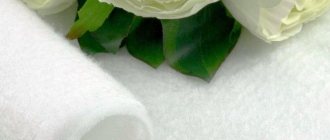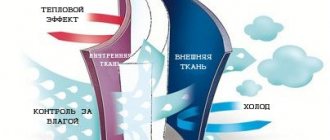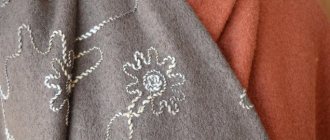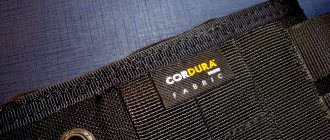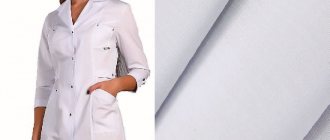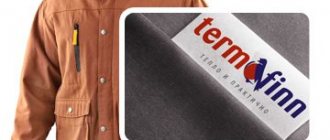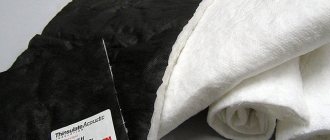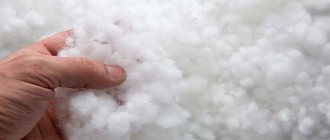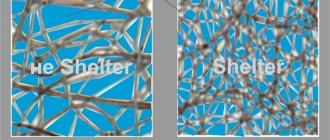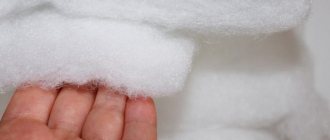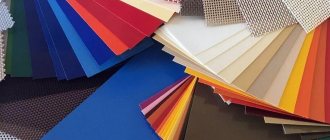Modern winter and demi-season clothing usually has insulation between the lining and the front surface. Its task is to retain heat; it must be breathable and as light as possible. Many insulation materials have such properties, and thermofin is only one of them. What advantages does this product have over analogues and how to choose its density correctly?
Manufacturing
The successful proportion of price and quality encourages an increasing number of manufacturers of demi-season and winter clothing to choose insulation such as thermofin . This is the result of research by Russian scientists who used Finnish technologies for creating materials for low temperatures. The new development went into wide production in 2009.
Termofin
is made from primary raw materials ; it includes both simple highly crimped fibers and bicomponent ones.
The latter have two elements: the core and the shell. When heated in an oven, the casing melts and adheres to the highly crimped fiber. But the core remains intact due to its increased refractoriness. The result is a material with a three-dimensional structure, filled with many air chambers , strong and very light.
Plus, thermofin fibers are combed both vertically and horizontally, which reduces thermal conductivity and increases volume . The manufacturing process itself is performed on high-precision German equipment. It is calibrated down to the minute and automated so that it is almost independent of the human factor.
At the output, deviations from the declared parameters in terms of weight, length and volume of the roll are no more than 2%, with the permissibility according to GOST up to 7% . This textile fabric also received the International Quality Certificate “Eco-Tex Standard 100” .
This is interesting: Needle-punched fabric - what is it: description, types
Product history
Until recently, almost all synthetic insulation materials were imported from other countries. Accordingly, the cost of finished products was higher. But in 2009, the Russian company decided to borrow Finnish manufacturing technology and produce its own raw materials - Termofin insulation. In this case, high-quality German equipment is used. Production facilities are located in the Moscow region. That is, everything is to the highest standard and in accordance with European standards.
Finland is a Scandinavian country where winters are no less severe than in Russia. Therefore, Finnish specialists are constantly working on various innovations that contribute to greater comfort when the thermometer needle drops below zero.
Varieties, to what air temperature they last
Depending on the thickness and ability to withstand low temperatures, thermofin insulation can be divided into several types (100, 150 and 200), up to what temperature they are operational - in the table below, reviews - later in the article.
| Type of insulation | Thickness | At what temperature is it operational? |
| Termofin 100 | 1.20 mm | -15°С |
| Termofin 150 | 2.20 mm | -22°С |
| Termofin 200 | 2.70mm | -30°С |
| Termofin 100 and 100 (two-layer) | 2.40 mm | -30°С |
| Termofin 100 and 150 (two-layer) | 3.40 mm | -35°С |
| Termofin 150 and 150 (two-layer) | 4, 40 mm | -42°С |
| Termofin 200 and 200 (two-layer) | 5, 40 mm | -55°С |
When making clothes, you need to consider what the surface and lining fabrics will be. They can provide additional protection from cold and wind.
Every year, modernized versions of insulation appear. So, in 2013, improved material Termofinn Plus . Its top layer is calendered with minimal fiber displacement, which makes it easier to cut the product.
A year later, clothing manufacturers were pleased with another new product called Termofinn micro . It is distinguished by a calendered “crust” and the presence of ultra-thin microfibers (up to 10 microns in diameter). They are 50 times more “graceful” than human hair and are surrounded by air, due to which the material “breathes”, but does not allow moisture to pass through from the outside, and also has antistatic properties.
Main characteristics of thermofinn
The insulation is produced according to international standards and has strictly specified characteristics.
- The material is available in the following thicknesses: 1.2 mm; 2.2 mm; 2.7 mm.
- The classic thermofinn will be able to retain heat at temperatures from -15°C to -30°C.
- The insulation density is: 100 g/m²; 150 g/m²; 200 g/m².
Thermofin layer
For sewing some types of clothing, two layers of fabric are used. At the same time, the thickness of the insulation increases by 2 times.
A two-layer thermofin will create comfortable conditions in frosts from -30°C to -55°C.
The fabrics of the outer covering and lining of clothing provide additional protection from wind and cold.
The manufacturing company is constantly improving the technological process.
In 2013, a new material, termofinn plus, was introduced, the properties of which were improved thanks to calendering. Passing the webs through calenders provides additional fixation of the fibers. The resulting material retains volume even better than classic thermofin.
In 2014, the company introduced a new product, termofinn micro, made from even finer fibers. In this case, more air capsules are formed in the insulation mass, which help retain heat.
What qualities does he have?
- Elasticity and softness . These parameters are achieved by the fact that most types of thermofin do not involve calendering, that is, rolling with hot rolls in order to compact the material or make it thinner. If a type of insulation requires such a process, then it is carried out using special technologies that do not reduce the quality of the product.
- Convenient volume and light weight . These indicators make it possible to work intensively in clothes with thermofin. With a thickness of 1.2 to 2.7 mm, the warm layer will not cause the product to become bulky.
- Water repellent properties . Termofin does not allow water to pass through and does not attract odors. Clothes dry quickly with it. At the same time, thanks to the air chambers, the textiles “breathe” and do not provoke sweating.
- High level of heat saving . It more than doubles the requirements of GOST R 12.4.236-2007.
- Durability .
If handled correctly, the product will last more than 10 years; it holds its shape well even after going through many washes. After five cleaning procedures, the shrinkage is approximately 0.2%, which is 10 times less than that prescribed in GOST. You can roll clothes: thermofin restores its shape well after being compressed. - Affordable price . In online stores you can purchase canvas from 150 rubles per linear meter. Accordingly, clothes using it are inexpensive. So, when buying a jacket on a thermofin, you can spend 2,000 rubles.
- Ease of cutting and sewing . The fabric does not crumble when cut, does not “creep” when sewing, does not flatten when stitching, and easily takes the desired shape. This helps save time on making clothes.
- Environmental friendliness and safety . As already mentioned, only primary raw materials are used in production. These are petroleum pellets, not recycled waste. Therefore, clothing with thermofin is recommended even for newborns or people suffering from allergic reactions.
What materials and insulation are used in the manufacture of such workwear as a women's winter suit, read in the next article.
Read about what the uniform for police officers should look like in this material.
And we’ll tell you here how to choose a uniform for a car wash, taking into account the image of the establishment.
Consumer Reviews
Many have already experienced clothing using thermofin insulation on themselves, here is what they think about it:
- Igor Rossokhin , security guard at the enterprise: “In overalls and a jacket insulated with thermofin, I spent the whole night outside at minus 23. I didn’t feel any discomfort or freezing of my limbs. It’s very convenient for my profession.”
- Valery Popov , master finisher: “Here we had to work “in the red” on the façade cladding. The jackets with thermofin that the company ordered were simply saved. You don't freeze, but at the same time you don't sweat. This property of the material is very important during intensive work.”
- Ivan Metlitsky , pensioner: “I love fishing, walking in the forest with dogs. We live in the north of Russia. Autumn, winter and spring are cold here, and age requires warmth. At a workwear store, my wife bought a jacket and overalls insulated with thermofin. I spend half the day in it. You don’t freeze even in a strong wind while fishing in winter.”
- Lyudmila Elenina , wife of an installer: “This kind of workwear is good for everyone. But, alas, it doesn’t look very attractive. I don’t like my husband in dark overalls; I want something brighter. But thanks to thermofin, it’s easy to wash and dries quite quickly.”
- Sergey Sevonin , driller: “We use winter suits with Thermofin 200 for the fourth climate zone. They are designed up to -40°C, but here we have cases down to -55°C. It's okay, they're holding on. We don’t freeze, and it’s comfortable to work – the clothes aren’t heavy.”
Workwear insulated with thermofin is a smart choice from reliable companies . After all, by taking care of the health of workers, they reduce the number of sick leave and increase labor productivity.
In conclusion, we suggest watching a video about the properties and qualities of thermofin insulation:
Composition and structure of insulation
Jacket pattern with thermofinn
High domestic demand for thermal protective materials is due to harsh climatic conditions.
Residents of northern countries have similar needs. For a long time, all good quality insulation materials were imported.
In 2009, the Termoreal company, using Finnish technology and European equipment, launched the production of a new synthetic insulation, ThermoFinn.
Please pay attention! The German company Thermofin, which produces refrigeration and ventilation equipment, has nothing to do with insulation.
Thermofinn is made from thin polymer raw materials delivered from South Korea. 85% of the fibers have a tortuous shape and internal cavities along the entire length. 15% of the fibrous material has a bicomponent structure. There is an outer shell around the flexible inner core.
The technological process for producing insulation consists of several stages.
- At the first stage, the raw materials are weighed under the control of computer programs.
- Then the fibers are combed out in horizontal and vertical directions. The result is a homogeneous, ordered product.
- The next stage is heat treatment. When the fabrics are fused in furnaces, the outer shell of the bicomponent fibers softens, as a result of which they join at the points of contact. A three-dimensional structure is formed. The heating temperature is controlled automatically. Fluctuations in temperature can lead to a sharp deterioration in quality.
- During subsequent molding, under the control of computer programs, the procedure of trimming the edges and cutting the canvases to a strictly specified length occurs.
- At the final stage, the insulation is vacuumed and then sent to the warehouse.
This is how the basic classic modification of thermofinn is made.
In what areas is it used?
Nowadays thermofin insulation is used when sewing a wide variety of types of clothing . These are city jackets and coats for the off-season and winter, children's jackets and overalls, envelopes for newborns, and sports models. A variety of hats are produced using this insulation. It is popular as a filling for pillows and blankets and a warm layer in sleeping bags.
Manufacturers of workwear and uniforms are the leaders in orders for thermofin for their production . After all, it creates the necessary comfort during operation in a variety of conditions, even extreme ones.
Suits, jackets and overalls for drillers and installers, dockers and logistics handlers, uniforms for guards and security guards - representatives of many professions will appreciate the benefits of products with thermofin.
In workwear for harsh male professions, they also take into account not only a large gradation of weather indicators, but also the physical activity of workers, as well as the duration of their stay in the open air at low temperatures.
This is interesting: Holcon - what is it: mattress filler, description
What can you sew with thermofinn insulation?
The material is multifunctional and can be used in everyday and extreme circumstances.
Thermofinn insulation is recommended for the manufacture of:
- clothes, hats for adults and children, including the youngest;
- special clothing for security guards, military personnel, people working in harsh conditions;
- sports equipment;
- home blankets, bedspreads, pillows.
Thermofinn insulation reliably retains heat in the most severe weather. Safe, lightweight, plastic material has an affordable price. Clothes with thermofinn will create comfort for many years.
Commercial properties of insulation
Environmental friendliness and safety. Termofinn does not accumulate odors and does not cause allergies. For its production, only primary raw materials are used - oil granules, and not processed recyclable materials mixed with garbage (glass shards, dirt, crumbs). Termofinn textile insulation has the International Quality Certificate “Eco-Tex Standard 100” for the 1st product category. Things using termofinn are safe even for kids.
Easy to cut and sew. The soft but elastic structure of the insulation does not crumble or climb. Practically does not flatten when quilting.
Excellently retains elasticity and shape after washing. Consisting of a low-melting shell and a polyester core, biocomponent fibers act as glue, so a highly crimped and thermally multiply bonded insulation structure is formed. Recovers well after compression. Shrinkage after 5 washes is 0.2%, which is 10 times less than GOST requirements.
Plasticity and softness due to the absence of a calendering “crust” sealing the upper and lower layers.
Light weight and excellent heat-saving protection in severe frosty weather, exceeding by more than 2 times the requirements of GOST R 12.4.236-2007. A huge number of air pores formed by the fibers reliably retain heat.
Dries quickly due to good moisture resistance.
Unpretentious clothing care:
- wash at 30°C with liquid detergents without bleach;
- gentle spinning and drying away from heating devices;
- Dry cleaning possible.
Advantages of Thermofinn
The insulation produced at the domestic enterprise, after thorough checks, was awarded an international quality certificate.
- All types of thermofinn are soft, light, elastic materials.
- The flexibility of the insulation allows a person to move easily.
- Thermofinn does not accumulate static electricity.
- The insulation allows air molecules to pass through well and does not create the effect of being in a greenhouse.
- Thermofinn repels water and does not get wet in rain and sleet.
- The insulation retains heat much better than all similar domestic products.
- Theromfinn retains all its properties for a long time. Clothes with it can be worn for more than 10 years. During this time, the lining and outer layer may wear out, but the insulation will retain all its qualities.
- The material is easy to care for. It can be easily washed. After 5 washes, it can shrink by 0.2%, which is tenths of a millimeter.
- Thermofinn is a domestic material, so its cost compares favorably with the price of imported products.
- The insulation is easy to cut and does not complicate the work of sewing masters.
- To obtain thermofinn, only primary certified raw materials are used. It does not contain any recycled polymers of questionable quality. The material is safe and approved for sewing children's clothing.
New fabric versions
The manufacturer has modernized the classic version of termofinn insulation and created 2 new versions of the product.
Termofinn Plus appeared on the market in 2013. It has a calendered surface with minimal fiber migration. The insulation features a more simplified cutting process.
In 2014, termofinn micro insulation with a calendered “crust” was introduced; it is certified according to GOST standards. The main feature is the presence of ultra-thin microfibers. Each microfiber, which is 50 times thinner than a hair and up to 10 microns in diameter, is surrounded by an air layer. Breathable material does not absorb moisture and remains dry. In addition, it has antistatic properties.
Previous
Modal fabric - what kind of fabric is it and where is it used?
Next
Chintz, what kind of fabric is it - its description and analogues
Let's compare different materials
Synthetic insulation has many advantages. In some respects, they are even superior to natural fabrics. Here's what's interesting about some of them. So, thermofinn or:
- Thinsulate. One of the warmest fabrics, it was created in America for astronaut suits and has unique thermoregulating properties. The material consists of myriads of hollow fibers, each of which is tens of times thinner than a human hair.
- Yunsen. This product of the Russian company of the same name will provide warmth and comfort even at a temperature of -25
OC. Its density is 200 g/m
2
. Made from primary raw materials with the addition of biocomponent fibers.
- Thermium. This excellent heat-return material is manufactured by the Belgian company Libeltex. It consists of an aluminum film with polyester fibers woven into it, which perfectly reflects human heat.
- Isosoft. Also a product of Libeltex. This is the thinnest of all synthetic insulation materials. It consists of hollow balls. Light and airy material is 3-4 times warmer than padding polyester.
- Hollophan. The name of the insulation consists of the English word hollow – “hollow” and the Fanema company that created it. The structure of the material contains hollow polyester fibers. Twisted into elastic springs, they hold their shape perfectly. The products are highly wear-resistant.
Characteristics and properties
- Softness. This is explained by the absence of a calendering process in the production chain. The insulation is not rolled with hot rolls to compact and thin the material.
- Low thermal conductivity. This is the result of the painstaking work of Finnish technologists and domestic manufacturers who created reliable fabric for the harsh Russian winters. The higher the density of the material, the warmer the product.
- Ease. The three-dimensional structure of the insulation consists of thin fiber and many air chambers that lighten the weight of the product.
- Fast drying. The material does not absorb moisture.
- Ecological cleanliness. The insulation is made without impurities, exclusively from granules of primary raw materials. Thermofinn is the holder of the Eco-Tex Standard 100 certificate, confirming the international quality standard.
- Does not accumulate unpleasant odors.
- Does not cause allergies.
- Durability and wear resistance. With proper handling, products retain their shape and original appearance for years.
- Affordable price. This insulation has no equal in the price segment.
Temperature
There are several types of thermofin insulation depending on the thickness of the material and the weather it is designed for.
| Insulation type: Termofin | Thickness | To what temperature |
| 100 g/sq.m | 1.20 mm | -15°С |
| 150 g/sq.m | 2.20 mm | -22°С |
| 200 g/sq.m | 2.70mm | -30°С |
| 100 g/sq.m and 100 g/sq.m (two-layer) | 2.40 mm | -30°С |
| 100 g/sq.m and 150 g/sq.m (two-layer) | 3.40 mm | -35°С |
| 150 g/sq.m and 150 g/sq.m (two-layer) | 4, 40 mm | -42°С |
| 200 g/sq.m and 200 g/sq.m (two-layer) | 5, 40 mm | -55°С |
For comparison
What temperature is synthetic insulation designed for? With a material density of 60 g/m2, clothes can be worn in warm spring and autumn, and with 300 g/m2 - at temperatures down to -25°C.
Clean, wash, dry
The insulating material is very easy to clean. It can be dry cleaned. Products made from thermofinn are washed at a temperature of 30
O
Without the use of bulk detergents and bleaches. It is recommended to squeeze them gently. You need to dry things away from heating devices.
Read about: Ecofiber
This magnificent insulating material will keep you warm even in the most severe frosts. And your sleep on soft pillows under the lightest blanket filled with thermofinn will be long and serene.
Where to buy Certificates
| Termoreal LLC | 109316, Moscow, Volgogradsky prospect, 47, office 409 | Tel/Fax (general) |
Where and how was thermofin invented and produced?
Russian thermofin is produced, but the technology for its production belongs to Finnish engineers. Specialists from TTI University (Tampere, Finland) and Termoreal have been working on the creation of this insulation for a long time. The task was to invent a material specifically for the climatic conditions of Russia. As a result, clothes with this filler can provide warmth at fairly low temperatures – down to –50°C.
Later, termofinn passed the relevant tests and was highly praised by specialists from Oeko-Tex Standard 100, a global organization for testing and certification of textile products. This material is assigned the highest class I, which means it is suitable for use by children under 2 years of age. Now thermofin is produced on an industrial scale using the latest German-made equipment.
This material has a wide range of applications. Today it is used for sewing winter clothes for children and adults, and products for sports. They make uniforms out of it for employees of various companies who are forced to spend their working hours outside. In addition, thermofin is used to fill bedding - pillows, blankets, mattresses, as well as products for newborns (warm covers for strollers, baby carriers, etc.).
Practical use
Termofinn is widely used in the following areas:
- sewing various demi-season and winter types of clothing (sports, fashion, children's, uniforms) and hats;
- insulation of tourist sleeping bags;
- filling blankets and pillows.
Termofinn’s corporate identity is successfully emphasized by hanging labels on finished products, which Termoreal LLC supplies clothing manufacturers free of charge. The letter “O” in the logo, stylized in the image of a bullfinch, which does not mind severe frosts, and the combination of blue and red colors, symbolizing warmth and cold, emotionally convey the main qualities of Termofinn products.
Advantages and disadvantages
Termofin is an almost ideal insulation material; its advantages include:
- softness, elasticity, lightness;
- high air conductivity;
- waterproof;
- durability. The material does not lose its properties for 10 years;
- high degree of heat retention. Filler with a density of 200 is operated at a temperature of minus 50°C;
- does not accumulate static electricity;
- does not cause allergies.
The material shows a minimum shrinkage of 0.2% after several washes.
Types of material
There are several main types of Thermolite material:
- Active - the material has a minimum volume, while completely retaining body heat.
- Base - used for the manufacture of sports underwear, due to the fact that it perfectly retains heat even with intense moisture, dries quickly and prevents chills. It has minimal weight, can be washed perfectly in a washing machine without shrinking and retaining its shape.
- Extreme – for extreme frost, the warmest of all types. It has three types of fibers in its structure: thin, thermally bonded, and spiral-shaped hollow. Thanks to this structure, the material is warm, light and resistant to deformation. This type of insulation is very durable and warm, perfectly restores its shape, and can be washed in a washing machine and dried. Used for making sleeping bags, sportswear and regular clothing.
- Extra is a more budget option than the previous one with excellent characteristics. Its structure has hollow fibers twisted in the form of a spiral, in which there are three holes that improve thermal conductivity. In terms of thermal insulation it is in second place after Extreme, 20% warmer. than goose down. It has just the perfect combination of cost, volume and weight.
- Micro – minimal volume of material provides excellent thermal insulation. It does not absorb odors and is used in the manufacture of sleeping bags and gloves.
- Plus is a special material for making winter clothing for severe frosts. About 80% of the material is improved polyester, has minimally fine fibers and fibers with holes. Thanks to this structure, it is very soft, does not cause allergies and is resistant to mechanical stress, warming even when wet. This material can be washed and dried in a washing machine many times without affecting its quality.
Thinsulate – space technologies
Back in 1973, on behalf of NASA, the American company 3M began developing an insulating material that could withstand even the cold of space.
Thinsulate
https://www.youtube.com/watch?v=VcjiJsORRlY
The efforts were crowned with success, and Thinsulate appeared, the production technology of which remained secret for many years. It was originally used to equip climbers and astronauts. In recent decades, this ultra-thin material has been successfully used in sewing both everyday and special clothing.
The material is made up of the finest polyester fibers, each of which is twisted into a small spiral. The second name for Thinsulate is artificial down, since in terms of warmth this filler can be compared with swan or eider down - one of the most delicate and weightless.
In addition, “space material” has a number of other advantages:
- hygroscopicity - does not accumulate moisture and dries quickly;
- lightness - the thickness of polyester fibers is several times less than the thickness of a human hair, so the fabric has almost no weight;
- breathability – Thinsulate does not interfere with air exchange, so clothing does not cause increased sweating;
- safety - completely synthetic material is resistant to high temperatures and combustion, it does not emit dangerous fumes, does not accumulate dust and pathogenic bacteria.
Warm and cozy material is indispensable for athletes involved in winter sports, climbers, polar explorers, hunters and fishermen.
Not so long ago, products under the Shelter brand appeared on store shelves. This is the first Russian insulation material that combines the qualities inherent in natural down and synthetic fibers.
So, which filler is warmer: thermofiber, isosoft or thinsulate? There is no definite answer to this question, since each of the insulation materials has a number of undeniable advantages. Whether to pay a higher price for the same warmth, comfort and coziness is up to the buyer to decide.
How to take care of things
Caring for products with such insulation is quite simple. Wash them at a temperature within 30°C, preferably on a delicate cycle. The spin speed is no more than 600 rpm. You can wash it by hand or take it to the dry cleaner.
| Can be used | Can not use |
|
|
The product should be dried in a ventilated room or in the open air. Do not place it on the radiator or try to dry it with a hairdryer.
What kind of insulation in winter clothes is Thermax?
- Auto and motorcycle Motorsport
- Car insurance
- Cars
- Service, Maintenance, Tuning
- Service, care and repair
- Choosing a car, motorcycle
- Traffic police, Training, Rights
- Registration of auto-moto transactions
- Other Auto Themes
- LEISURE AND ENTERTAINMENT Arts and entertainment
- Military service
- Health
- First meal
- Friendship
- Computers
- Hometasks
- Independent holiday
- Work environment
- Parenting
Scope of application: what to sew
Holofiber is available in 3 types: granules-balls, canvas and plates.
- Granule ball is the most common and familiar type of filler. The fibers twist to form balls ranging in size from a pea to a ping pong ball. This form of material holds its shape well, does not get knocked down or deformed - it is used to stuff pillows, toys, used as a filler for blankets and gives a three-dimensional shape to decorative items.
- Non-woven fabric. Holofiber in sheets is available in different thicknesses from 60 to 4000 gm.sq. The thinnest canvas is used in landscape design. Fabrics with a density of 100 to 300 gm/sq are used as insulation for clothing. Denser fabrics, due to their thickness, density and elasticity, are excellent for making mattresses and upholstered furniture. There are three main types of furniture holofiber: there are also hard fabrics (hard) for creating a frame and flooring, medium (medium) for the top layer and soft (soft) for quilted elements and decorative elements.
- Plates (layers, mats) are produced for construction needs; they are an excellent insulation and sound insulator. Both soft and hard pressed mats are available.
Different types of holofiber are also used in light industry, mechanical engineering, the space industry and aviation.
Thermofiber of various densities and thicknesses is used in various fields. Due to its lightness and high level of thermal insulation ability, it is used to sew:
- Outerwear.
- Home textiles.
- Furniture covering.
Use allows you to significantly reduce the weight and volume of the finished product, which is important when sewing outerwear. Find out about the knitwear catalog from Beloshveyka Raskazovo at this link.
In mattresses
Bulky nonwoven fabric is often used to make mattresses and flooring. The fiber has a high level of compression, resembling the action of springs. This feature gives the mattress an additional orthopedic effect.
We suggest you read: How and how to remove old paint from a wooden surface?
Durable and wear-resistant fabric with a density of 750-800 g/m2 has a long service life and has good heat transfer properties. The fibers ensure air circulation, making mattresses made from this material suitable for children and people with allergies and bronchial asthma. For people with an allergic reaction to certain types of fabric, clothes are also made from nettle.
Varieties
May have several types. All varieties are made from polyester fibers and differ only in density and thickness. Depending on the thickness and length of the thread, thermofiber is divided into:
- Soft. The material is soft, light and very closely resembles natural down. It is universal and can be used in various areas where insulation is necessary. The thickness to length ratio is 7D/32.
- Hard. The ratio of fiber diameter to length is 15D/64. The canvas has good elasticity and quickly restores its original shape. Less elastic, therefore suitable for filling large parts.
- Vatu. In appearance, the water resembles natural cotton material. It is characterized by low density and low weight. Thin fibers are short in length, which ensures the airiness of the material. However, it is less durable than other varieties.
- Balloons. They are made from both hard and soft threads. Strongly twisted fibers are collected into small lumps-balls. The variety is characterized by an increased degree of elasticity and restoration of condition.
Production stages
- The computerized system mixes bicomponent and conventional high-crimp fibers in the correct proportions (15% and 85%).
- The mixture is sent to a container where it is combed both vertically and horizontally. Thus, the output material is uniform, without lumps or compactions.
- Next, everything is placed in a melting furnace, where, under the influence of high temperatures, ordinary and bicomponent fibers are glued together, forming very strong compounds. The holding time is very important here, because any deviation in one direction or another will spoil the material, making it either too hard or too loose.
- Sharp knives trim uneven edges to width.
- The finished material is rolled into rolls.
First meeting
It was created by analogy with the fur of a polar bear, inside the fibers of which there is air that prevents heat loss.
Made from synthetics (polyester), the fiber is hollow and has a large surface area, contains air, which acquires the temperature of the human body and maintains it, preventing hypothermia. In case of increased physical activity, increased temperature and sweating, moisture is wicked out, creating a feeling of comfort and dryness.
Description of fabric, cost
So, what is polyester in jackets, what is such a filler? This, if you don’t go into details, is a loose mass of a huge number of very thin polyethylene fibers, movably fastened together. The air that is trapped inside it retains the heat generated by the human body. Moreover, the volume of this air in the thickness of the polyester insulation directly determines how effective the latter will be.
- Simple polyester fillings for jackets, “working” according to the principle “thicker layer - more air cavities in the weave of fibers - better heat retention.” These are padding polyester, padding polyester, holofiber, etc. They will not cost much at all. The thinnest padding polyester, for example, will cost about 200 rubles. per linear meter.
- More modern polyester insulation. They are more difficult to produce and cost more, but are more efficient in operation. Manufacturers have achieved a reduction in the required filler thickness due to the special structure of the fibers and the addition of calender layers on one or both sides. The lower price level for such materials is 250-350 rubles (various fleeces) per 1 linear line. m., upper – 2500 rubles (branded Polartek, USA).
Isosoft – European quality
In 2003, the Belgian company Libeltex, which develops and produces non-woven products made from synthetic fibers, patented an innovative material called “isosoft”.
Isosoft consists of tiny polyester balls, the space between which is filled with air. It is this air gap that makes the material surprisingly warm.
The outside of the insulation is covered with a two-layer polymer coating, which completely prevents cold air from getting under the clothes. By not allowing heat to penetrate outside, isosoft, at the same time, does not create a “greenhouse effect”, since all excess moisture has a free exit through the pores of the material. Isosoft is available in different densities, which allows it to be used in clothing for different seasons:
- 50 – 75g/m2 – for demi-season clothing;
- 100 – 160 g/m2 – for late autumn and early winter;
- 250 – 300 g/m2 – for severe winter frosts.
In general, the temperature range at which you can feel cozy and comfortable in clothes with isosoft ranges from 10 to -300C.
